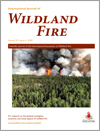International Journal of Wildland Fire
Volume 29
Number 6 2020
We investigated the main drivers of spotting in wildfires by analysing infrared aerial images and environmental data for 338 spotting wildfires in south-east Australia. We found source fire area to be the most important predictor of spotting distance and number of spot fires (>500 m), with important secondary effects of fuel, weather and topography.
We analysed trends in human- and lightning-caused wildfires ≥ 2 ha in Canada for two time periods: 1959–2018 and 1981–2018. For the 1959–2018 period, 48% of wildfires were attributed to human cause, while 52% were due to lightning. For the 1981–2018 period, 44% of wildfires were attributed to humans and 56% to lightning.
We developed global and spatial quantile regression models to investigate the spatially varying relationships between forest fires and environmental factors at different quantiles of fire occurrence. Both models can identify the relationship between fire at different occurrence levels and their influencing factors; in particular, the spatial quantile regression model can provide more spatial information on the relationship across a large region and will be beneficial for fire management and prevention planning.
We present an improved TBSI (temperature burn scar index) for mapping cropland burned areas caused by wildfires. The new model was applied to a winter wheat agricultural region in the Haihe River Basin in northern China. The results indicate that the proposed method is robust and accurate.
Tree growth provides an index of vigour; we demonstrate that measures of pre-fire tree growth appear to influence probabilities of delayed post-fire mortality in common conifers of the western USA. Fire severity is thus partially a function of tree vigour, and consequently may be affected by changing environmental conditions.
Post-fire organic litter and herbaceous cover depend on whether or not other disturbances precede fire. Resulting differences in ground cover affect post-fire regeneration of conifers. Litter cover promoted high-density conifer regeneration after fire-only, but inhibited it when blow-down or beetle outbreak preceded fire. Likewise, herbaceous cover promoted conifer regeneration after fire-only, but inhibited it when bark beetle outbreak preceded fire.
Fire mosses are early successional species that can colonise severely burned landscapes. We conducted a survey of 10 wildfires in the southwestern USA. Fire moss cover increased in shaded north-facing hillslopes in relatively wet locations. When compared with the bare soil surface, fire mosses reduced erosion and enhanced water infiltration.
This study is the first to present how wildfires change the quality of dissolved organic matter (DOM) in boreal forest soil water as measured by ultra-high-resolution mass spectral analysis. The results suggest that fire generated several species of black carbon, but changed the DOM molecular composition only slightly because burned plant residues provided diverse lignin-like molecules in soils.
Measurement of surface dead fine fuel moisture content is integral to wildfire management but challenging using conventional techniques. We assessed the ability of automated fuel sticks to estimate surface dead fine fuel moisture and concluded that they could be useful as a coarse measure of moisture after calibration.





